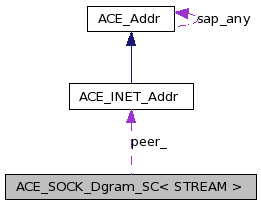"Dgram_SC" is short for "Datagram Self-Contained." More...
#include <IOStream_T.h>

Public Member Functions | |
| ACE_SOCK_Dgram_SC (void) | |
| ACE_SOCK_Dgram_SC (STREAM &source, ACE_INET_Addr &dest) | |
| ssize_t | send_n (char *buf, ssize_t len) |
| ssize_t | recv (char *buf, ssize_t len, ACE_Time_Value *tv=0) |
| ssize_t | recv (char *buf, ssize_t len, int flags, ACE_Time_Value *tv=0) |
| ssize_t | recv_n (char *buf, ssize_t len, int flags=0, ACE_Time_Value *tv=0) |
| int | get_remote_addr (ACE_INET_Addr &addr) const |
Protected Attributes | |
| ACE_INET_Addr | peer_ |
"Dgram_SC" is short for "Datagram Self-Contained."
Datagrams don't have the notion of a "peer". Each send and receive on a datagram can go to a different peer if you want. If you're using datagrams for stream activity, you probably want 'em all to go to (and come from) the same place. That's what this class is for. Here, we keep an address object so that we can remember who last sent us data. When we write back, we're then able to write back to that same address.
Definition at line 257 of file IOStream_T.h.
| ACE_SOCK_Dgram_SC< STREAM >::ACE_SOCK_Dgram_SC | ( | void | ) | [inline] |
Definition at line 39 of file IOStream_T.inl.
{
}
| ACE_SOCK_Dgram_SC< STREAM >::ACE_SOCK_Dgram_SC | ( | STREAM & | source, | |
| ACE_INET_Addr & | dest | |||
| ) | [inline] |
Definition at line 44 of file IOStream_T.inl.
: STREAM (source),
peer_ (dest)
{
}
| int ACE_SOCK_Dgram_SC< STREAM >::get_remote_addr | ( | ACE_INET_Addr & | addr | ) | const [inline] |
Definition at line 117 of file IOStream_T.inl.
{
addr = peer_;
return 0;
}
| ssize_t ACE_SOCK_Dgram_SC< STREAM >::recv | ( | char * | buf, | |
| ssize_t | len, | |||
| ACE_Time_Value * | tv = 0 | |||
| ) | [inline] |
Definition at line 59 of file IOStream_T.inl.
| ssize_t ACE_SOCK_Dgram_SC< STREAM >::recv | ( | char * | buf, | |
| ssize_t | len, | |||
| int | flags, | |||
| ACE_Time_Value * | tv = 0 | |||
| ) | [inline] |
Definition at line 69 of file IOStream_T.inl.
{
if (tv != 0)
{
ACE_HANDLE handle = this->get_handle ();
ACE_Handle_Set handle_set;
handle_set.set_bit (handle);
switch (ACE_OS::select (int (handle) + 1,
(fd_set *) handle_set, // read_fds.
(fd_set *) 0, // write_fds.
(fd_set *) 0, // exception_fds.
tv))
{
case 0:
errno = ETIME;
case -1:
return -1;
default:
; // Do the 'recv' below
}
}
int rval = STREAM::recv (buf, len, peer_, flags);
#if defined (ACE_WIN32)
if (rval == SOCKET_ERROR)
if (::WSAGetLastError () == WSAEMSGSIZE)
if (ACE_BIT_ENABLED (flags, MSG_PEEK))
rval = len;
#endif /* ACE_WIN32 */
return rval < len ? rval : len;
}
| ssize_t ACE_SOCK_Dgram_SC< STREAM >::recv_n | ( | char * | buf, | |
| ssize_t | len, | |||
| int | flags = 0, |
|||
| ACE_Time_Value * | tv = 0 | |||
| ) | [inline] |
Definition at line 107 of file IOStream_T.inl.
| ssize_t ACE_SOCK_Dgram_SC< STREAM >::send_n | ( | char * | buf, | |
| ssize_t | len | |||
| ) | [inline] |
Definition at line 52 of file IOStream_T.inl.
{
return STREAM::send (buf, len, peer_);
}
ACE_INET_Addr ACE_SOCK_Dgram_SC< STREAM >::peer_ [protected] |
Definition at line 278 of file IOStream_T.h.
 1.7.0
1.7.0